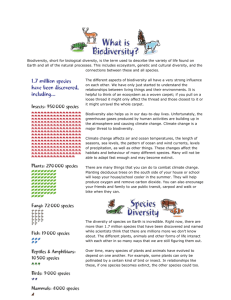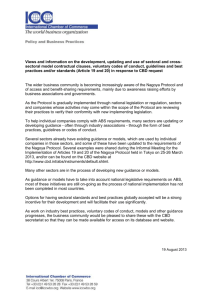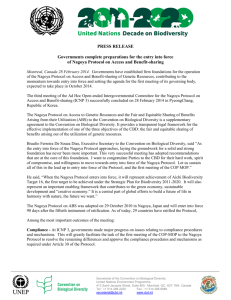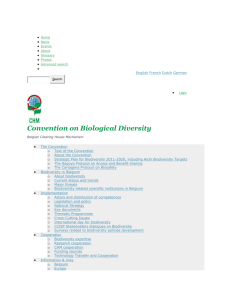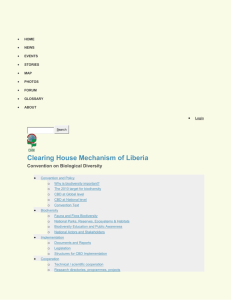Press Release Historic UN biodiversity pact on genetic resources
advertisement
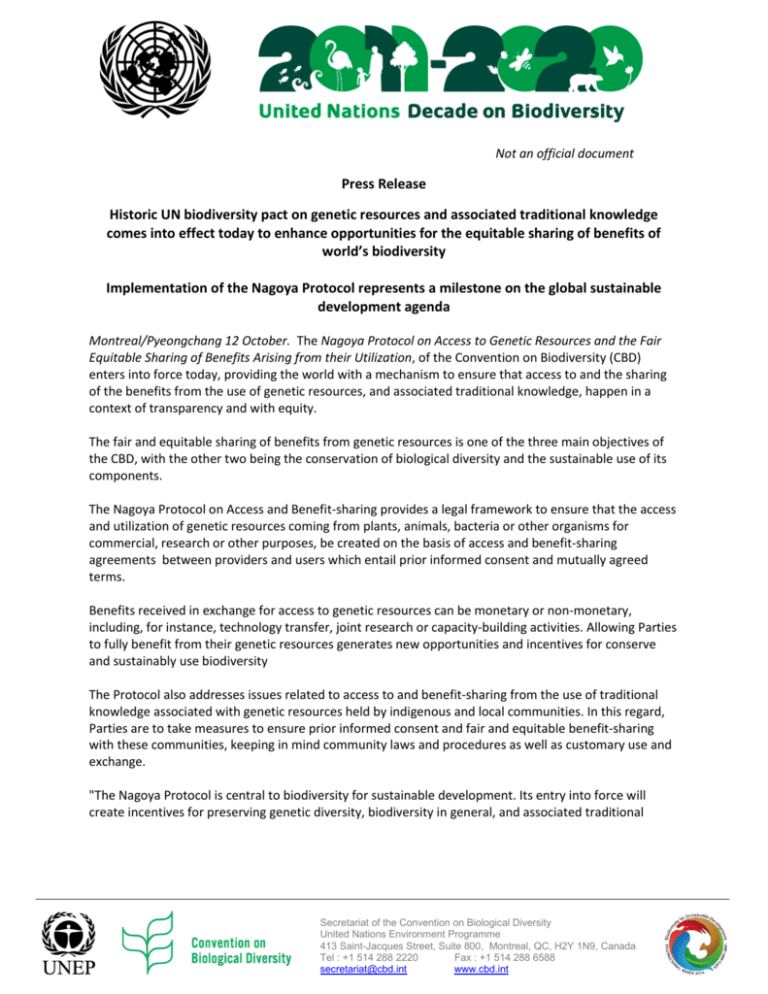
Not an official document Press Release Historic UN biodiversity pact on genetic resources and associated traditional knowledge comes into effect today to enhance opportunities for the equitable sharing of benefits of world’s biodiversity Implementation of the Nagoya Protocol represents a milestone on the global sustainable development agenda Montreal/Pyeongchang 12 October. The Nagoya Protocol on Access to Genetic Resources and the Fair Equitable Sharing of Benefits Arising from their Utilization, of the Convention on Biodiversity (CBD) enters into force today, providing the world with a mechanism to ensure that access to and the sharing of the benefits from the use of genetic resources, and associated traditional knowledge, happen in a context of transparency and with equity. The fair and equitable sharing of benefits from genetic resources is one of the three main objectives of the CBD, with the other two being the conservation of biological diversity and the sustainable use of its components. The Nagoya Protocol on Access and Benefit-sharing provides a legal framework to ensure that the access and utilization of genetic resources coming from plants, animals, bacteria or other organisms for commercial, research or other purposes, be created on the basis of access and benefit-sharing agreements between providers and users which entail prior informed consent and mutually agreed terms. Benefits received in exchange for access to genetic resources can be monetary or non-monetary, including, for instance, technology transfer, joint research or capacity-building activities. Allowing Parties to fully benefit from their genetic resources generates new opportunities and incentives for conserve and sustainably use biodiversity The Protocol also addresses issues related to access to and benefit-sharing from the use of traditional knowledge associated with genetic resources held by indigenous and local communities. In this regard, Parties are to take measures to ensure prior informed consent and fair and equitable benefit-sharing with these communities, keeping in mind community laws and procedures as well as customary use and exchange. "The Nagoya Protocol is central to biodiversity for sustainable development. Its entry into force will create incentives for preserving genetic diversity, biodiversity in general, and associated traditional Secretariat of the Convention on Biological Diversity United Nations Environment Programme 413 Saint-Jacques Street, Suite 800, Montreal, QC, H2Y 1N9, Canada Tel : +1 514 288 2220 Fax : +1 514 288 6588 secretariat@cbd.int www.cbd.int knowledge. It will provide the conditions for continuous research and development on genetic resources. But most importantly, the Protocol will give us the opportunity to develop an economy that is more sustainable and where the value of natural resources will be truly acknowledged” said Braulio Ferreira de Souza Dias, Executive Secretary of the Convention on Biological Diversity. “The entry of the landmark Nagoya Protocol into force with 51 ratifications, ahead of the Aichi deadline, opens up opportunities for the fair and equitable sharing of the benefits from the utilization of genetic resources. At the same time, it offers a reminder that the Aichi targets are within reach,” said Achim Steiner, UN Under-Secretary-General and Executive Director of the UN Environment Programme. "The Protocol will create greater equity and transparency for both providers and users of genetic resources which will enhance the contribution of biodiversity to development, poverty eradication and human well-being," “It is up to us - here and now - to build momentum to encourage further ratifications, strengthen political will and take decisive measures to keep the Aichi Targets on track," he added. The historic treaty is the result of decades of negotiations, which culminated in the Protocol being agreed on 29 October 2010, in Nagoya, Japan. However, 50 Parties to the CBD had to ratify before it could enter into force. The Protocol received its final necessary ratification on 14 July 2014. It now has 54 ratifications. The implementation of the Protocol also contributes to the achievement of the Aichi Biodiversity Target 16. Target 16 provides that the Nagoya Protocol should enter into force and be operational by 2015. “The entry into force of the Protocol will contribute to enhancing the benefits to all from biodiversity and ecosystem services and it represents a major step towards achieving Target 16 prior to our target date,” said Braulio Ferreira de Souza Dias, Executive Secretary of the Convention on Biological Diversity, at the opening of the capacity building workshop on the Access and Benefit-sharing Clearing-House (ABS-CH) this Sunday, in Pyeongchang, Republic of Korea. On this occasion, Parties celebrated the entry into force of the Nagoya Protocol and the launching of the operational phase of the online platform. With entry into force of the Protocol, the ABS-CH will also become operational. The ABS-CH will act as a platform where countries can exchange information which will enhance legal certainty and transparency on procedures for access and for monitoring the use of genetic resources. The ABS-CH will also help connecting users and providers of genetic resources and associated traditional knowledge. Mr. Prakash Javadekar, Minister of State for Environment, Forests & Climate Change of India, who is expected to serve as president for the first meeting of the Conference of the Parties serving as the Meeting of the Parties to the Protocol (COP MOP 1) said: “By providing legal certainty on the use of genetic resources and associated traditional knowledge, and by strengthening the opportunities for fair and equitable sharing of benefits arising from their use, the Protocol will create incentives to conserve biodiversity, and sustainable use of its components, and further enhance the contribution of biodiversity to sustainable development and human well-being.” The first meeting of the Conference of the Parties serving as the meeting of the Parties to the Nagoya Protocol on Access and Benefit-sharing (COP-MOP 1), begins on 13 October and will last until 17 October. At its first session, Parties to the Protocol will discuss matters related to the ABS-CH; model contractual clauses, voluntary codes of conduct, capacity-building; awareness raising; the need for and modalities of a global multilateral benefit-sharing mechanism; cooperative procedures and institutional mechanisms to promote compliance and to address cases of non-compliance; and guidance on resource mobilization including to the financial mechanism. Mr. Dias announced that “the implementation of the Nagoya Protocol represents a milestone not only for the Convention on Biological Diversity, but also in the history of global governance for sustainable development”. The Nagoya Protocol is strictly linked with the sustainable development agenda. “The sustainable use of biological diversity plays a key role in poverty eradication and environmental sustainability, thereby contributing to achieving the Millennium Development Goals,” Mr. Dias said. “In the same vein, the implementation of the Nagoya Protocol will certainly be of valuable importance in the achievement of the proposed Sustainable Development goals which are set to become part of the post2015 development agenda.” Notes for Editors The Nagoya Protocol on Access to Genetic Resources and the Fair and Equitable Sharing of Benefits Arising from their Utilization was adopted at the tenth meeting of the Conference of the Parties in 2010, in Nagoya, Japan, and significantly advances the objective of the Convention on the fair and equitable sharing of benefits arising from the utilization of genetic resources by providing greater legal certainty and transparency for both providers and users of genetic resources. By promoting the use of genetic resources and associated traditional knowledge, and by strengthening the opportunities for fair and equitable sharing of benefits from their use, the Protocol will create incentives to conserve biodiversity, sustainably use its components, and further enhance the contribution of biodiversity to sustainable development and human well-being. The full text of the Nagoya Protocol is available at: www.cbd.int/abs/doc/protocol/nagoya-protocol-en.pdf. The list of signatories of the Nagoya Protocol is available at: www.cbd.int/abs/nagoya-protocol/signatories/ . The Convention on Biological Diversity (CBD) Opened for signature at the Earth Summit in Rio de Janeiro in 1992, and entering into force in December 1993, the Convention on Biological Diversity is an international treaty for the conservation of biodiversity, the sustainable use of the components of biodiversity and the equitable sharing of the benefits derived from the use of genetic resources. With 194 Parties up to now, the Convention has near universal participation among countries. The Convention seeks to address all threats to biodiversity and ecosystem services, including threats from climate change, through scientific assessments, the development of tools, incentives and processes, the transfer of technologies and good practices and the full and active involvement of relevant stakeholders including indigenous and local communities, youth, NGOs, women and the business community. The Cartagena Protocol on Biosafety is a supplementary agreement to the Convention. It seeks to protect biological diversity from the potential risks posed by living modified organisms resulting from modern biotechnology. To date, 167 countries plus the European Union have ratified the Cartagena Protocol. The Secretariat of the Convention and its Cartagena Protocol is located in Montreal. For more information visit: www.cbd.int. Contact David Ainsworth, Information Officer at david.ainsworth@cbd.int or +82 (0)10 2149 0526 (until 17 October 2014) or Johan Hedlund at johan.hedlund@cbd.int

